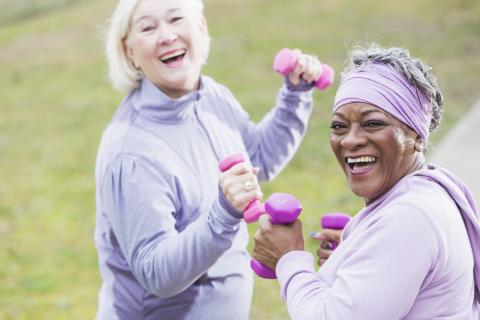Does Aging Mean We Should Slow Down? Evolution Says No!
Lieberman and his running buddy, Aaron Baggish, who is a cardiologist with Massachusetts General Hospital (and, by the way, is the team cardiologist for the New England Patriots), conducted research that sheds light on the reason why it is so important to exercise in our later years. They say that the need for staying active was built right into our biology as we evolved!
In a November 2021 study, they compared human beings to our close evolutionary relatives, chimpanzees. These animals only live to the age of 35 or so in the wild. “We evolved basically from couch potatoes,” said Lieberman, who has observed wild chimpanzees in Tanzania, surprised by how much of their day is spent, as he puts it, “sitting on their butts, digesting.”
In contrast, humans with a hunter-gather lifestyle are quite active, and fossil records show a longer lifespan was common among humans by 40,000 years ago—and so was the human “health span,” meaning the years of life that a person is in good health.
Why does exercise help our species live longer?
First of all, physical activity helps us burn calories rather than storing unhealthy extra fat. And physical activity strengthens the body at the molecular, cellular and tissue levels. “This includes repairing tears in muscle fibers, repairing cartilage damage, and healing microfractures. The response also causes the release of exercise-related antioxidants and anti-inflammatories, and enhances blood flow,” the team reported. “The cellular and DNA repair processes have been shown to lower the risk of diabetes, obesity, cancer, osteoporosis, Alzheimer’s, and depression.”
Lieberman reports that as technology replaces a lot of the work people used to do, many humans are less active these days. But even if our daily tasks don’t require us to be active, we still need to be. “The key take home point is that because we evolved to be active throughout our lives, our bodies need physical activity to age well,” he said. “In the past, daily physical activity was necessary in order to survive, but today we have to choose to exercise, that is, do voluntary physical activity for the sake of health and fitness.”
Exercise for everyone
Things get a little more complicated when we consider other evolutionary factors. A 2018 study from the University of Geneva in Switzerland used neurologic imaging to show that our brains often balk at getting on that treadmill. Resistance to exercise is something we have to overcome. The researchers explained that our ancient ancestors had to work hard for their calories, so there was a built-in resistance to expending energy if they didn’t have to. But most people in the U.S. have access to ample caloric intake, so we have the opposite problem.
A lifetime of physical activity lowers our risk of many health problems, and of premature death. If you’ve always been active, take a bow! But even if you’ve traditionally been more of a chimpanzee than an athlete, it’s never too late to add more physical activity to your life. Ask your doctor for a “prescription” for appropriate activities, tailored for your health conditions. An exercise prescription for older adults will typically include:
Aerobic activity, which increases heart rate and breathing, bringing more oxygen to the body (for example: walking, dancing).
Muscle strengthening and flexibility exercise that keeps muscles and ligaments strong (for example: stretching, lifting weights).
Balance training, to prevent falls and enhance confidence in exercising (for example: balance classes, tai chi).
Exercise classes tailored for older adults are available at senior centers, health clubs, and parks and recreation departments. Many senior living communities have fitness programs. During the pandemic, older adults have been accessing online exercise opportunities, and studies even demonstrate the aerobic and flexibility benefits of active video game. Adapted activities are available for people living with mobility, sensory or cognitive challenges.
Exercise need not be formal. Just going for a walk, working in the garden or even house cleaning provides a good dose of activity. So get off the couch and get moving! Imagine your ancient ancestors giving you a big thumbs up.
The information in this article is not intended to replace the advice of your health care provider. Ask your doctor for an exercise program that’s right for you.
